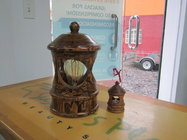I recently discovered Mike Peace’s 4-inch lantern ornament
View: https://www.youtube.com/watch?v=6L2hlKPNH04
and made several to sell here in Mexico. The customer liked it so much he now wants a giant one and dropped off a 17 inch by 9 inch rosewood log. My biggest concern is the size of the four holes. Mike drilled 7/8” holes in a 2 ½” by 5” blank. How big can my holes be for, say a 10” tall lantern before it becomes impossible to turn the thing safely? And since I’m working with a round piece to start with, is there a way to space the 4 holes accurately?
and made several to sell here in Mexico. The customer liked it so much he now wants a giant one and dropped off a 17 inch by 9 inch rosewood log. My biggest concern is the size of the four holes. Mike drilled 7/8” holes in a 2 ½” by 5” blank. How big can my holes be for, say a 10” tall lantern before it becomes impossible to turn the thing safely? And since I’m working with a round piece to start with, is there a way to space the 4 holes accurately?

